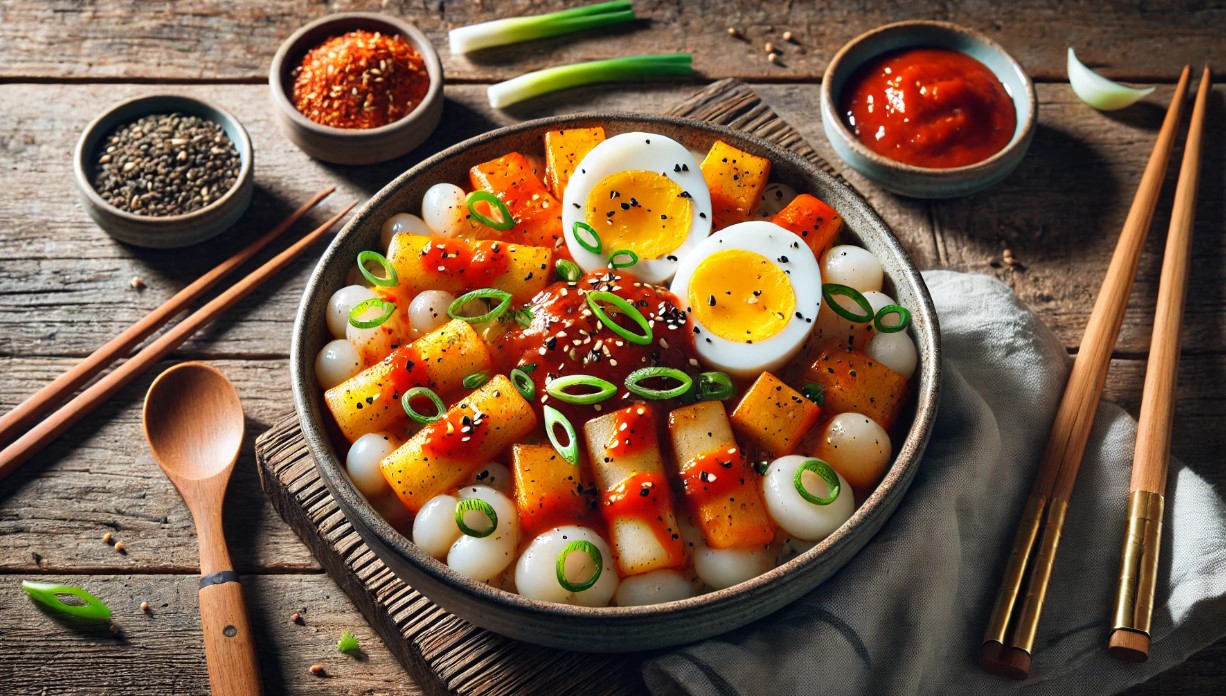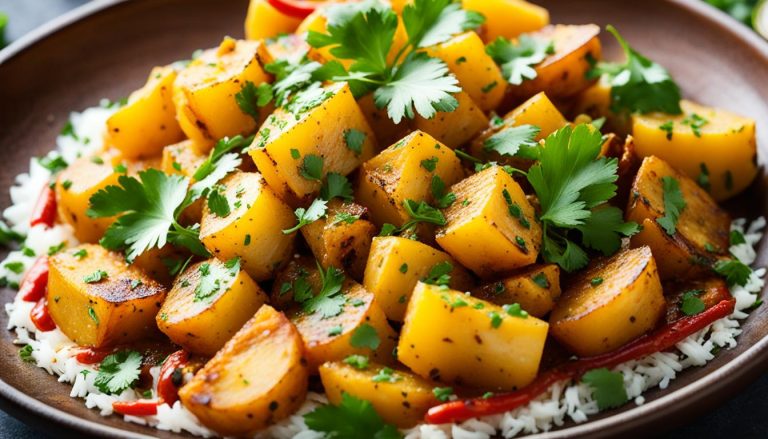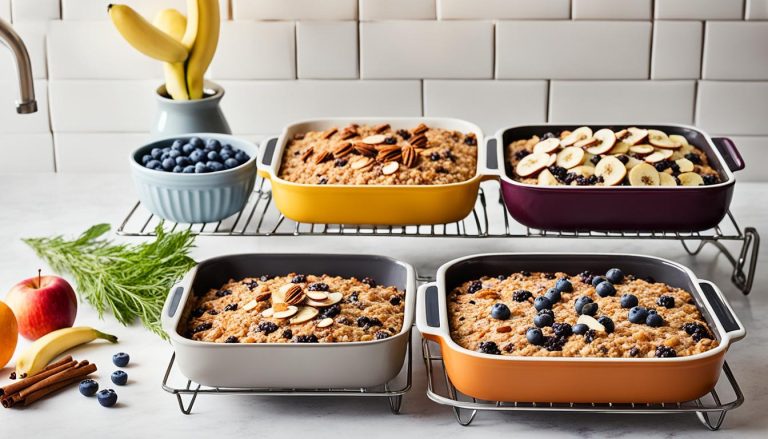Tteokbokki (떡볶이) is a beloved Korean street food that has taken the world by storm. This spicy, savory dish made with chewy rice cakes, a rich and flavorful sauce, and various toppings, is a perfect combination of comfort and excitement.
Whether you’ve visited Korea and fallen in love with it on the spot, or you’ve only just heard of it through social media, learning how to make tteokbokki at home will bring the authentic taste of Korean cuisine right into your kitchen.
In this comprehensive guide, I will take you step-by-step through the process of preparing this iconic dish, from the ingredients to the cooking methods. Get ready to recreate this mouthwatering delicacy in your own home!
What Is Tteokbokki?
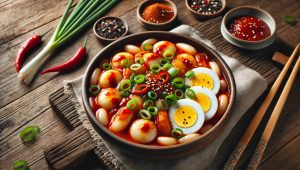
Tteokbokki is a traditional Korean dish made from tteok (떡), which are rice cakes, and a rich, spicy-sweet sauce. The rice cakes used for tteokbokki are chewy and cylindrical in shape, typically made from glutinous rice flour. Tteokbokki is commonly found at street food stalls, where vendors prepare it quickly and serve it hot in a small bowl for people to eat on the go.
The sauce that coats the rice cakes is made from gochujang (고추장), a Korean red chili paste that gives the dish its signature spice and depth of flavor. Along with the gochujang, ingredients like gochugaru (Korean red pepper flakes), garlic, and soy sauce are used to create a savory, sweet, and spicy mixture that clings to the chewy rice cakes.
Though tteokbokki was traditionally served as a street food snack, it has become a popular dish that can be enjoyed as a full meal. Over time, different variations have emerged, with different additions like boiled eggs, fish cakes, or vegetables, and tteokbokki can even be served in a rich broth, or stir-fried for a more intense flavor.
Ingredients for the Perfect Tteokbokki
The key to an amazing tteokbokki lies in using the right ingredients and finding the perfect balance of flavor. Here’s what you’ll need:
| Ingredient | Amount |
| Tteok (rice cakes) | 300g (about 2 cups) |
| Gochujang (chili paste) | 3 tablespoons |
| Gochugaru (pepper flakes) | 1 tablespoon |
| Soy Sauce | 2 tablespoons |
| Sugar | 1 tablespoon |
| Garlic (minced) | 2-3 cloves |
| Fish Cakes (Eomuk) | 100g |
| Boiled Eggs | 2 |
| Green Onion (chopped) | 1 stalk |
| Anchovy or Vegetable Broth | 1 ½ cups |
| Sesame Oil (optional) | 1 teaspoon |
- Tteok (Rice Cakes): The traditional tteokbokki rice cakes are soft, chewy, and cylindrical, and they can be found at Korean grocery stores. These rice cakes, also called garaetteok (가래떡), should be about 2–3 inches long and ½ inch thick. They are usually made from steamed glutinous rice flour. If you can’t find garaetteok, you can substitute with dduk or any type of rice cake that has a similar chewy texture.
- Gochujang (Korean Chili Paste): This deep red paste is the heart and soul of tteokbokki’s rich, spicy flavor. Gochujang provides both heat and depth, making the dish flavorful but not overwhelming.
- Gochugaru (Korean Red Pepper Flakes): Gochugaru adds an extra layer of spice and depth to the sauce. It also brings a slight smokiness to the dish, which balances the sweet notes from the sugar and the saltiness from soy sauce.
- Soy Sauce: Soy sauce helps in adding the savory umami flavor to the tteokbokki sauce, making it more complex. You can use either dark soy sauce or light soy sauce depending on your preference. Dark soy sauce offers a deeper, more intense flavor.
- Sugar: A little bit of sugar goes a long way in balancing the spice and salt in tteokbokki. The sweet and spicy combination is what makes this dish so irresistible.
- Garlic: Freshly minced garlic adds a touch of savory aromatic flavor to the sauce and complements the gochujang perfectly.
- Fish Cakes (Eomuk): Fish cakes are a classic addition to tteokbokki, giving the dish extra texture and flavor. You can use sliced fish cakes, which are available in most Asian grocery stores.
- Boiled Eggs (Optional): Many tteokbokki recipes include boiled eggs. The soft, creamy yolks contrast wonderfully with the spicy sauce.
- Green Onions: Chopped green onions are used as a garnish and bring a fresh, aromatic touch to the dish.
- Broth :Tteokbokki can be made with either water or anchovy broth (or fish stock). Broth will add a layer of depth to the dish that water cannot. To make the anchovy broth, you can simmer dried anchovies, kelp, and water together.
Equipment You’ll Need
- A medium-sized pan or wok for cooking.
- Spatula or spoon for stirring.
- Strainer if using anchovy broth.
- Knife and cutting board for chopping the fish cakes, eggs, and green onions.
How to Make Tteokbokki: Step-by-Step Instructions
Step 1: Prepare the Ingredients

- If you’re using dried rice cakes, you’ll need to soak them in warm water for at least 30 minutes to rehydrate. This will give them their characteristic chewy texture. If you’re using fresh rice cakes, you can skip this step.
- Boil eggs if you’re planning to include them in your recipe. After boiling, peel and set them aside.
- Slice the fish cakes into bite-sized pieces (you can also tear them if they are pre-sliced).
- Chop the green onions into small pieces, leaving some larger segments for garnish at the end.
Step 2: Make the Sauce
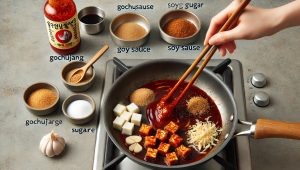
- In a pan, combine the gochujang, gochugaru, soy sauce, sugar, and minced garlic. Add about 1 ½ cups of water or anchovy broth and stir until the sauce is smooth and the ingredients are well combined.
- Bring the sauce to a simmer over medium heat, stirring occasionally to make sure the sauce doesn’t burn. Let it simmer for about 5 minutes to allow the flavors to meld together.
Step 3: Add the Rice Cakes

- Once your sauce has thickened slightly, add the rice cakes to the pan. Stir the rice cakes into the sauce, ensuring that they are completely coated. Cook for 10–15 minutes, stirring occasionally. The rice cakes should absorb the sauce, making them more flavorful and tender.
Step 4: Add the Fish Cakes and Eggs

- Once the rice cakes are nearly done, add your sliced fish cakes and boiled eggs to the pan. Stir gently to combine. The fish cakes will soften and absorb some of the sauce, making the dish even more flavorful.
Step 5: Simmer

- Continue simmering the mixture on low heat for an additional 5 minutes, making sure that everything is thoroughly heated through and the sauce has thickened to a syrupy consistency.
Step 6: Garnish and Serve
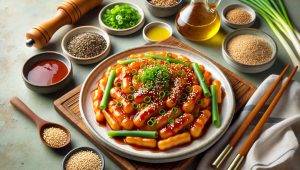
- Transfer your finished tteokbokki to a serving dish. Garnish with chopped green onions and any other toppings of your choice. You can even drizzle a bit of sesame oil for an extra layer of flavor.
Step 7: Enjoy!
- Serve the dish hot, with plenty of extra sauce to enjoy with the chewy rice cakes and savory fish cakes. Tteokbokki is best enjoyed immediately, while it’s piping hot and fresh.
Variations of Tteokbokki
While the recipe I’ve shared is a traditional one, you can customize your tteokbokki based on your tastes and the ingredients available to you. Here are some common variations:
- Cheese Tteokbokki: A creamy and indulgent variation, where mozzarella cheese is added to the dish for a cheesy, gooey texture. This version is particularly popular among younger audiences and can be topped with cheese right at the end to melt into the sauce.
- Spicy and Sweet Tteokbokki: If you love your food with a bit more sweetness, increase the amount of sugar or honey in the sauce. This variation is sweeter than the traditional version but still packs a punch.
- Vegetarian Tteokbokki: For a vegetarian-friendly option, simply omit the fish cakes and use vegetable stock instead of anchovy broth. Add extra vegetables like cabbage, carrots, or mushrooms for a hearty, flavorful dish.
- Stir-Fried Tteokbokki: Some people prefer their tteokbokki stir-fried rather than simmered. This variation results in a more concentrated sauce and a slightly crispy texture on the rice cakes.
Tteokbokki Serving Tips
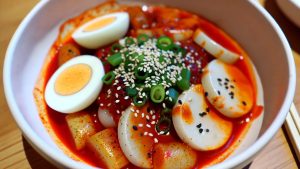
- Side Dishes: Tteokbokki is often enjoyed with kimchi, pickled radish, or a simple salad to balance the spiciness. It can also be served with steamed rice for a more substantial meal.
- Drink Pairings: Tteokbokki pairs wonderfully with a cool drink to offset the heat. Popular choices include iced tea, soju, or a refreshing glass of water with lemon.
Nutritional Information (per serving, approx. 1 cup)
| Nutrient | Amount | % Daily Value (based on 2,000-calorie diet) |
| Calories | 300-350 kcal | 15-18% |
| Protein | 10g | 20% |
| Total Fat | 7g | 11% |
| Saturated Fat | 1g | 5% |
| Carbohydrates | 50g | 17% |
| Dietary Fiber | 3g | 12% |
| Sugars | 10g | 20% |
| Sodium | 800-1,000 mg | 35-40% |
| Cholesterol | 40 mg | 13% |
| Potassium | 250 mg | 7% |
| Vitamin A | 2% | 2% |
| Vitamin C | 6% | 6% |
| Calcium | 4% | 4% |
| Iron | 8% | 8% |
Final Thoughts
Tteokbokki is a dish that brings warmth and excitement to any meal. Its combination of chewy rice cakes, spicy gochujang sauce, and flavorful fish cakes creates a dish that’s hard to resist. Whether you are cooking it for yourself, your friends, or your family, tteokbokki is sure to be a crowd-pleaser.
Now that you know how to make this delicious Korean street food in your own kitchen, don’t hesitate to try it. And remember, tteokbokki is all about balancing the flavors, so feel free to experiment and adjust the spice levels to your liking. So go ahead, get cooking, and enjoy this unforgettable Korean delicacy!
FAQs
What is tteokbokki made of?
Tteokbokki is made of chewy rice cakes (tteok), a spicy-sweet sauce made from gochujang (Korean chili paste), gochugaru (red pepper flakes), soy sauce, garlic, and sugar, along with optional additions like fish cakes, boiled eggs, and vegetables.
Can I use any rice cakes for tteokbokki?
For the best texture, use garaetteok, which are cylindrical, chewy rice cakes. If you can’t find them, any similar rice cakes can work, but soaking dried rice cakes beforehand is recommended for better texture.
Is tteokbokki very spicy?
Tteokbokki has a mild to medium spice level due to gochujang and gochugaru. You can adjust the heat by varying the amount of chili paste and pepper flakes used in the sauce.
Can I make tteokbokki without fish cakes?
Yes, you can omit fish cakes and substitute with other ingredients, like vegetables, tofu, or even extra rice cakes. Tteokbokki can still be delicious without them.
Can I store leftover tteokbokki?
Yes, leftover tteokbokki can be stored in an airtight container in the fridge for up to 2–3 days. Reheat it in a pan, adding a bit of water to loosen up the sauce if it thickens too much.
How do I make tteokbokki less sweet?
To reduce the sweetness, decrease the amount of sugar or honey in the sauce. You can also balance it with a little more soy sauce or a dash of vinegar to cut through the sweetness.
Can I make tteokbokki vegetarian?
Yes, you can make tteokbokki vegetarian by skipping the fish cakes and using vegetable broth instead of anchovy stock. Add vegetables like mushrooms, cabbage, or carrots for extra flavor.

Tteokbokki Recipe
Ingredients
- 300 g Tteok (rice cakes) about 2 cups
- 3 tablespoons Gochujang chili paste
- 1 tablespoon Gochugaru pepper flakes
- 2 tablespoons Soy Sauce
- 1 tablespoon Sugar
- 2-3 cloves Garlic minced
- 100 g Fish Cakes Eomuk
- 2 Boiled Eggs
- 1 stalk Green Onion chopped
- 1 ½ cups Anchovy or Vegetable Broth
- 1 teaspoon Sesame Oil optional
Instructions
- If you're using dried rice cakes, you’ll need to soak them in warm water for at least 30 minutes to rehydrate. This will give them their characteristic chewy texture. If you're using fresh rice cakes, you can skip this step.
- Boil eggs if you're planning to include them in your recipe. After boiling, peel and set them aside.
- Slice the fish cakes into bite-sized pieces (you can also tear them if they are pre-sliced).
- Chop the green onions into small pieces, leaving some larger segments for garnish at the end.
- In a pan, combine the gochujang, gochugaru, soy sauce, sugar, and minced garlic. Add about 1 ½ cups of water or anchovy broth and stir until the sauce is smooth and the ingredients are well combined.
- Bring the sauce to a simmer over medium heat, stirring occasionally to make sure the sauce doesn’t burn. Let it simmer for about 5 minutes to allow the flavors to meld together.
- Once your sauce has thickened slightly, add the rice cakes to the pan. Stir the rice cakes into the sauce, ensuring that they are completely coated. Cook for 10–15 minutes, stirring occasionally. The rice cakes should absorb the sauce, making them more flavorful and tender.
- Once the rice cakes are nearly done, add your sliced fish cakes and boiled eggs to the pan. Stir gently to combine. The fish cakes will soften and absorb some of the sauce, making the dish even more flavorful.
- Continue simmering the mixture on low heat for an additional 5 minutes, making sure that everything is thoroughly heated through and the sauce has thickened to a syrupy consistency.
- Transfer your finished tteokbokki to a serving dish. Garnish with chopped green onions and any other toppings of your choice. You can even drizzle a bit of sesame oil for an extra layer of flavor.
- Serve the dish hot, with plenty of extra sauce to enjoy with the chewy rice cakes and savory fish cakes. Tteokbokki is best enjoyed immediately, while it’s piping hot and fresh.


